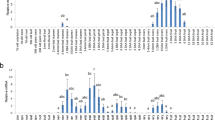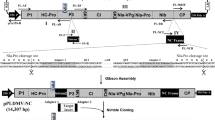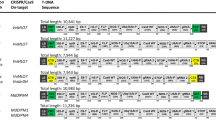Abstract
Transgenic tobacco and eggplants expressing the coding region of the iaaM gene from Pseudomonas syringae pv. savastanoi, under the control of the regulatory sequences of the ovule-specific DefH9 gene from Antirrhinum majus, showed parthenocarpic fruit development Expression of the DefH9-iaaM chimeric transgene occurs during flower development in both tobacco and eggplant. Seedless fruits were produced by emasculated flowers. When pollinated, the parthenocarpic plants produced fruits containing seeds. In eggplant, the genetic manipulation allowed fruit set and growth under environmental conditions prohibitive for fruit setting in the untransformed line, which did not set fruit at all. Under normal environmental conditions, production of marketable fruits took place from pollinated and unpollinated transgenic flowers, while flowers of untransformed control plants did produce fruits of marketable size only from fertilized flowers.
This is a preview of subscription content, access via your institution
Access options
Subscribe to this journal
Receive 12 print issues and online access
$209.00 per year
only $17.42 per issue
Buy this article
- Purchase on Springer Link
- Instant access to full article PDF
Prices may be subject to local taxes which are calculated during checkout
Similar content being viewed by others
References
Mapelli, S., Frova, C., Torti, G., Soressi, G.R. 1978. Relationship between set, development and activities of growth regulators in tomato berries. Plant Cell Physiol. 19: 1281–1288.
Gillapsy, G., Ben-David, H. and Gruissem, W. 1993. Fruits: a developmental perspective. Plant Cell 5: 1439–1451.
Lipari, V. and Paratore, A. 1988. Parthenocarpy and auxinic treatments in fruiting of tomato in a cold greenhouse. Ada. Hort. 229: 307–312.
Lin, S., George, W.L. and Splittstoesser, W.E. 1988. Expression and inheritance of parthenocarpy in “Severianin” tomato. J. Hereof. 75: 62–66.
Kihara, H. 1951. Triploids water melons. Proc. Amen Soc. Hort. Sci. 58: 217–230.
Khishnamoorthy, H.N. 1981. Plant growth substance-including application in agriculture. Tata McGray Publishing Company, Ltd., New Delhi, India
Archbold, D.D. and Dennis, F.G. 1985. Strawberry receptacle growth and endogenous IAA content as affected by growth regulator application and achene removal J. Amer. Soc. Hort. Sci. 110: 816–820.
Nitsch, J. 1950. Growth and morphogenesis of the strawberry as related to auxin. Amer.J. Bot 37: 211–215.
Spena, A., Estruch, J.J. and Schell, J.J. 1992. On microbes and plants: new insights in phytohormonal research. Cur. Opin. Biotechnol. 3: 159–163.
Yamada, T., Palm, C.J., Brooks, B. and Kosuge, T. 1985. Nucleotide sequence of the Pseudomonas savastanoi indoleacetic acid genes show homology with Agrobacterium tumefaciens T-DNA. Proc. Natl. Acad. Sci. USA 82: 6522–6526.
Gaudin, V., Vrain, T. and Jouanin, L. 1994. Bacterial genes modifying hormonal balances in plants. Plant Physiol. Biochem. 32: 11–29.
Kawaguchi, M., Kobayashi, M., Sakurai, A. and Syono, K. 1991. The presence of an enzyme that converts indole-3-acetamide into IAA in wild and cultivated rice. Plant Cell Physiol. 32(2): 143–149.
Northman, J., Rylski, I. and Spigelman, M. 1979. ern, fruit growth and colour development of egg-plant during the cool season in a subtropical climate. Scientia Hortic. 11: 217–222.
Wang, D., Wu, Z. and Zhi, J. 1980. Effects of meteorological factors on the percentage of setting fruit of summer and autumn eggplants in Beijing district. Acta. Hort. Sinica 7: 31–36.
Nitsch, J. 1960. Natural growth substances in Concord and Concord seedless grapes in relation to berry development. Am. J. Bot. 47: 566–576.
Koncz, C. and Schell, J. 1986. The promoter of TL-DNA gene 5 controls the tissue-specific expression of chimaeric genes carried by a novel type of Agrobacterium binary vector Mol. Gen. Genet 204: 383–396.
Arpaia, S., Mennella, G., Onofaro, V., Perri, E., Sunseri, F. and Rotino, G.L. 1997 Production of transgenic eggplant Solanum melongena L. resistant to Colorado Potato Beetle (Leptinotarsa decemlineata -Say-) Theor. Appl. Genet. In press
Huijser Klein, J., Lonnig, W.-E., Meijer, H., Saedler, H. and Sommer, H. 1992. Bracteomania, an inflorescence anomaly, is caused by the loss of function of the MADS-box gene squamosa in Antirrhinum majus. EMBO J. 11: 1239–1249.
Author information
Authors and Affiliations
Rights and permissions
About this article
Cite this article
Rotino, G., Perri, E., Zottini, M. et al. Genetic engineering of parthenocarpic plants. Nat Biotechnol 15, 1398–1401 (1997). https://doi.org/10.1038/nbt1297-1398
Received:
Accepted:
Issue Date:
DOI: https://doi.org/10.1038/nbt1297-1398
This article is cited by
-
Genome-wide identification and characterization of parthenocarpic fruit set-related gene homologs in cucumber (Cucumis sativus L.)
Scientific Reports (2023)
-
Downstream of GA4, PbCYP78A6 participates in regulating cell cycle-related genes and parthenogenesis in pear (Pyrus bretshneideri Rehd.)
BMC Plant Biology (2021)
-
CPPU may induce gibberellin-independent parthenocarpy associated with PbRR9 in ‘Dangshansu’ pear
Horticulture Research (2020)
-
Comparison of regeneration capacity and Agrobacterium-mediated cell transformation efficiency of different cultivars and rootstocks of Vitis spp. via organogenesis
Scientific Reports (2019)
-
Genetic engineering of parthenocarpic tomato plants using transient SlIAA9 knockdown by novel tissue-specific promoters
Scientific Reports (2019)



